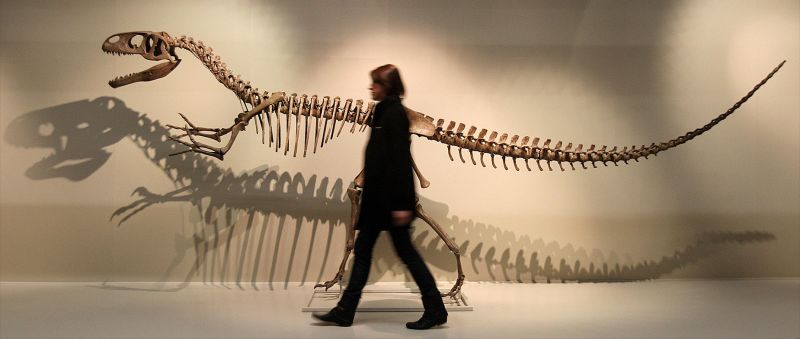
Earliest Skin Fossil Shatters Previous Record by 130 Million Years

New study reveals the ancient reptile ancestor that predates dinosaurs by 130 million years, boasting the oldest fossilized skin ever discovered
Researchers have discovered the world's oldest fossilized skin, belonging to a reptile species that existed before the time of the dinosaurs. The fossilized reptile skin was unearthed in a limestone cave located in Oklahoma, United States, and is estimated to be at least 130 million years older than the previously known oldest skin fossil.
The University of Toronto Mississauga researchers have discovered a fragment of skin with a pebbled texture that resembles crocodile skin. This ancient sample dates back around 289 million years, making it the oldest known preserved epidermis from terrestrial reptiles, birds, and mammals. The press release notes that the development of the epidermis was a crucial evolutionary adaptation for these species as they transitioned to life on land.
Sirius Passet's fossilized organisms give us a glimpse into the ancient pelagic ecosystem, showcasing Timorebestia as a dominant predator in the water column over 518 million years ago. Credit: Artwork by Bob Nicholls/@BobNichollsArt
Artwork by Bob Nicholls/@BobNichollsArt
Newly discovered large predator worms ruled the seas as Earths earliest carnivores, study finds
First author Ethan Mooney, a paleontology graduate student at the University of Toronto, stated, "Occasionally, we are presented with a remarkable opportunity to peek into the distant past. These kinds of findings have the potential to greatly enhance our comprehension and appreciation of these groundbreaking animals."
According to biology professor Robert Reisz from the University of Toronto Mississauga, who specializes in vertebrate paleontology, it is uncommon to come across fossilized skin despite it being the largest organ in the body. Reisz explained that skin decomposes easily after an animal dies. However, he noted that the sample was preserved due to the distinctive features of the Richards Spur limestone cave system, where some of the oldest examples of early terrestrial animals have been discovered.
Reisz told CNN that the cave conditions were extremely unusual due to the unique chemistry of the clay sediment, water, and presence of hydrocarbons. Animals that entered the cave would have been buried in fine clay sediments, slowing decomposition, and then they would have interacted with hydrocarbons from the seeping oil, preserving their skin. Additionally, researchers believe the cave was likely an oxygenless environment.
Bill May, an amateur collector, donated thousands of samples to the team in 2018, according to Reisz. While most were recognizable bone samples, the team was particularly intrigued by the "delicate" skin fossil, as it was only about a quarter of a millimeter thick. Upon microscopic examination, the team discovered epidermal tissues in the tiny skin fossil, which was smaller than a fingernail.
Lizard-like animal
Mooney expressed, "The sight was absolutely astonishing, as it defied all our expectations. Discovering a fossilized skin of such ancient origin presents an extraordinary chance to glimpse into the past and visualize the appearance of the skin of some of the earliest creatures."
The pebbled skin surface of the fossil is akin to that of a crocodile, with hinged regions between scales resembling those found in snakes and worm lizards. However, researchers are unable to identify the animal or body region from which the sample originated due to the lack of association with any other remains.
But Reisz told CNN that the skin would have belonged to "a small little animal looking somewhat like a lizard."
The Dead Zoo at Large - Treasures of the Natural History Museum is on display at The National Museum at Collins Barracks. Natascia Soannini is pictured walking past a Megalosaurus skeleton as part of the exhibition, which opened on Thursday, April 30, 2009. The temporary exhibition serves as a replacement for the closure of the 1857 building on Merrion Street. Photo credit: Julien Behal/PA Wire URN:7217489
Megalosaurus, the fossil that first brought dinosaurs to the attention of the world. It is believed that the skin may have belonged to a small reptile called Captorhinus, which has been found in the cave system more frequently than any other animal.
The fact that the sample shares some similarities with living reptiles highlights the significance of skin for land-dwelling animals. "The epidermis was a critical feature for vertebrate survival on land," noted Mooney, emphasizing its role as a crucial barrier between internal body processes and the harsh outer environment.
Furthermore, the specimen could serve as a representation of a skin formation that eventually developed into avian feathers and mammalian hair follicles, as stated in the press release. The findings of the research were documented in the Current Biology journal.
Sign up for CNNs Wonder Theory science newsletter. Explore the universe with news on fascinating discoveries, scientific advancements and more.













